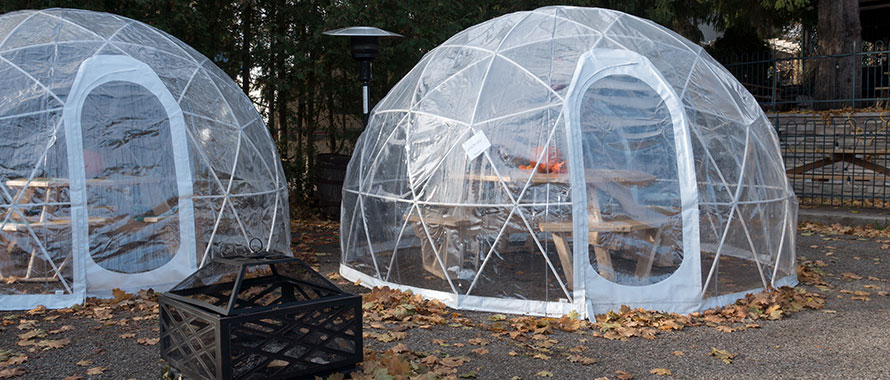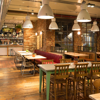A brewery in Michigan recently opened several “craft beer shanties” where customers can be served outside while indoor dining is temporarily restricted statewide. The owner of Brass Ring Brewing in Alger Heights reportedly modeled the enclosed wooden structures after ice fishing shanties and said they can be reserved in 90-minute blocks by groups of four, as long as the guests are from the same household.
The restaurant is one of many establishments in the U.S. and Canada building temporary outdoor dining structures in an effort to keep business flowing amid surging COVID-19 cases, new restrictions on indoor dining, and cooling temperatures. The options range from pole tents and igloo domes to more elaborate “streeteries” made from plywood and complete with lighting and heating.
“The hospitality industry is really struggling,” said Bonnie Steen, CPCU, Vice President, Associate Managing Director, Burns & Wilcox, New Orleans, Louisiana. “Restaurants are doing anything they can to try to survive the pandemic right now, to just make enough money to stay in business.”
Temporary structures could present a different kind of peril for these struggling businesses, however. Restaurant owners need to ensure these projects comply with local regulations and will be covered by their Commercial Property Insurance and Commercial General Liability (CGL) Insurance. They will also want to keep coronavirus precautions in mind, especially as some experts question the benefit of moving customers to closed-off “outdoor” spaces that could nearly be considered “indoors.”1

Building a structure for guests to dine outside may defeat the purpose of being outside. Before committing to the extra costs to build a structure, they need to make sure it is within government guidelines and advise their insurance company to confirm coverage.
“Building a structure for guests to dine outside may defeat the purpose of being outside,” said Patricia Sheridan, CIP, Director, Commercial Insurance, Burns & Wilcox, Toronto, Ontario. “Before committing to the extra costs to build a structure, they need to make sure it is within government guidelines and advise their insurance company to confirm coverage.”
Structure design should adhere to fire codes, COVID-19 restrictions
In New York City, construction company DB Partners is in the process of building dozens of “streeteries” for restaurants after pivoting from office construction earlier this year. According to the owner, building an outdoor dining structure takes about three days and the cost ranges from $5,000 to $25,000. To meet city regulations, structures built on the street get electric heating while sidewalk structures are heated by natural gas or propane.
How these structures are heated is a serious consideration for restaurants and the contractors who build them. “Basic code compliance is one of the biggest exposures,” said Michelle Picklesimer, Underwriting Director, Burns & Wilcox, Detroit/Farmington Hills, Michigan. “Are the materials flame-retardant? Will the structure meet fire codes and what kind of heating are they using? What is the ventilation?”
Contractors who get involved in this type of work should review their Architects, Engineers and Contractors Professional Liability Insurance and Errors & Omissions (E&O) Insurance to check for any exclusions on temporary structures. “Even if they were working on restaurants exclusively and then they are moving to temporary structures, it is a different exposure,” Picklesimer said.
Beyond standard code compliance, restaurants and builders need to keep up with regional guidelines related to COVID-19 that may dictate acceptable ventilation and other project components. In Windsor, Ontario, Vito’s Pizzeria recently had its three plastic “dining domes” shut down after authorities said they did not comply with outdoor dining rules.2 The Windsor-Essex County Health Unit reportedly cited COVID-related guidelines that require covered outdoor dining areas to have at least two full sides open to the outdoors, and also noted concerns with fire safety codes and local bylaws.
“Most of these restaurants are already financially strained, so you do not want to do something like this that is not going to be allowed and then have to have it taken down, which is again an additional cost,” Sheridan said.
Once a business owner confirms that its outdoor dining plans meet government guidelines, the next step is confirming coverage for the structure under the restaurant’s Commercial Property Insurance and CGL Insurance. “The underwriters can then take it into consideration to see if it complies with their guidelines and what risk mitigation strategies might be recommended,” Sheridan said. “It is always in the insured’s best interest to let the insurance company know about any type of change or addition.”
Depending on the cost of the structure, one immediate impact may be needing to update the policy’s property value and business contents limit, Steen added. “If the outdoor structure is attached to the building and the cost is $50,000, then the price of the building just went up and they may have to adjust the amount of insurance they carry on the building,” she said.
Storm damage, slip-and-fall injuries among potential perils
When Tropical Storm Isaias hit New Jersey in August, powerful winds destroyed outdoor dining spaces at multiple restaurants and led to thousands of dollars in property losses.3 Temporary structures may be more susceptible to wind, hail and other storm damage due to weaker materials, Steen explained.
“After what we have been through in Louisiana this year with so many hurricanes, I would be concerned about wind,” she said. “If there is rain or snow, there could be a collapse loss.”
Property damage from a storm or fire would be covered under a restaurant’s Commercial Property Insurance, which covers the physical property and its business contents. If a storm caused a direct damage loss by a covered peril and caused a restaurant to shut down temporarily, lost revenue may also be covered if the restaurant carried business interruption coverage on its policy, Sheridan said.
In 2018, fires caused 3,655 deaths and 15,200 injuries in the U.S.4 Dining structure heating elements that are accessible to a customer, like fire pits or standing propane-fueled patio heaters, can be particularly hazardous. Authorities in Canada issued a safety notice in October5 about the dangers of patio heaters, noting that these must be installed correctly, properly ventilated and kept a safe distance from flammable objects.

Anytime you are adding temporary heating, you have to be very careful about the risk of fire and asphyxiation.
“These heaters can be very dangerous,” Steen said, especially in places where alcohol is served and customers may be intoxicated. “If you have a customer who stands up near the heater and takes one misstep, their clothing could catch fire. Anytime you are adding temporary heating, you have to be very careful about the risk of fire and asphyxiation.”
Bodily injury or property damage to third parties due to fire or other incidents that occur on the business premises could be covered by the restaurant’s CGL Insurance. Injuries sustained by employees, meanwhile, would be covered under a business’s Workers’ Compensation Insurance, Steen noted.
In many cases, the presence of a temporary heating source inside of a potentially flammable space such as a tent would make the outdoor dining structure an unacceptable risk to an insurance carrier, Sheridan explained. Tripping hazards are another potential source of injury in these structures. “Extra poles sticking out could cause a fall if they are not marked properly,” she said.
Restaurants could also put customers at risk by installing outdoor seating close to busy roads or in areas otherwise used for parking. “If you have someone sitting in your restaurant, the chances of a car going through a restaurant are a lot less than a car going up onto the sidewalk or into a parking lot,” Steen said. “You definitely pick up some additional liability.”
With that an absolute auto exclusion, if someone crashes into the outdoor parking lot seating area the CGL Insurance policy would probably not respond to that loss. “The CGL Insurance policy might say anything related to an auto is not covered,” she said.
Despite concerns about the safety of more enclosed dining spaces, liability for coronavirus transmission is unlikely to be covered by a restaurant’s insurance policies, Steen said. While some states have considered granting businesses immunity from this type of claim5, if any and all COVID-19 protocol is strictly followed “you can still get sued and have to go to court,” Steen noted.
Restaurants can transfer risk by using third-party contractors
Restaurants are encouraged to use qualified and insured third-party contractors when taking on an outdoor dining structure project — not only for the benefit of the contractor’s experience, but also because it is “essentially a risk transfer for them,” Picklesimer explained. “If the restaurant does all of the work themselves, then they are assuming all of that liability as the restaurant owner.”
A contractor can be held liable if a structure fails or someone is injured due to a faulty design or installation, Steen added. “Insureds should try to transfer the risk of these types of losses to the contractor’s insurance policy,” she said.
Construction companies rely on Architects, Engineers and Contractors Professional Liability Insurance and E&O Insurance to protect them against losses caused by mistakes made in their professional services. These professionals might also consider Excess Liability Insurance to obtain higher limits, or a protective indemnity enhancement, which sets aside a separate limit for the legal liability of the general contractor to its subcontractors, Picklesimer said.
“General contractors can purchase this extra layer of limit to protect them against their subcontractor’s errors,” she explained. “Another newer coverage they may also want is a faulty workmanship carve-back, which bridges the gap between the CGL Insurance and the Professional Liability Insurance.”
COVID-19 and other communicable disease exclusions are not common in Professional Liability Insurance policies, but any potential liability for virus transmission would have to directly link an outbreak back to a problem with the contractor’s design, Picklesimer said. “There could also be liability if the company was completely negligent in adhering to the Centers for Disease Control and Prevention’s guidelines,” she said.
In professional liability, every form is different. It is important for a broker to understand your needs and the exposures completely
At a time when construction delays are common due to the pandemic6, it is more important than ever for contractors to review their contracts, make necessary changes and consider adding a force majeure clause, Picklesimer suggested. “This is a clause in contracts that essentially releases both parties from obligation when there is an extraordinary event or circumstance beyond the control of the parties, like COVID-19,” she said.
Contractors should discuss this and other risk mitigation strategies with a knowledgeable insurance broker who understands their business operations. “In professional liability, every form is different,” Picklesimer emphasized. “It is important for a broker to understand your needs and the exposures completely.”
The same advice applies for restaurant owners considering the addition of temporary dining structures or other changes, Sheridan said. “It is up to the broker to help the business owner and recommend the appropriate limits, coverages and prevention measures,” she said. “It is important to work with a reputable broker who is familiar with this line of business and can identify any potential issues.”
Sources 1 Holder, Sarah; and Capps, Kriston. “The Indoorification of Outdoor Dining.” Bloomberg CityLab, November 27, 2020. 2 CBC News. “Walkerville restaurant outdoor 'dome dining' shut down by public health protocols.” Canadian Broadcasting Corporation, October 31, 2020. 3 CBS New York. “Restaurants Dependent On Outdoor Dining Dealt Another Blow By Tropical Storm Isaias.” WLNY, August 5, 2020. 4 U.S. Fire Administration. “U.S. fire statistics.” Federal Emergency Management Agency, July 2019. 5 James, Erica; and Krncevic, Raymond. “States Take the Lead With Business Covid-19 Immunity Statutes.” Bloomberg Law, October 23, 2020. 6 Rodgers, Arleigh. “Construction projects face delays during pandemic.” Ithaca.com, September 2, 2020.









